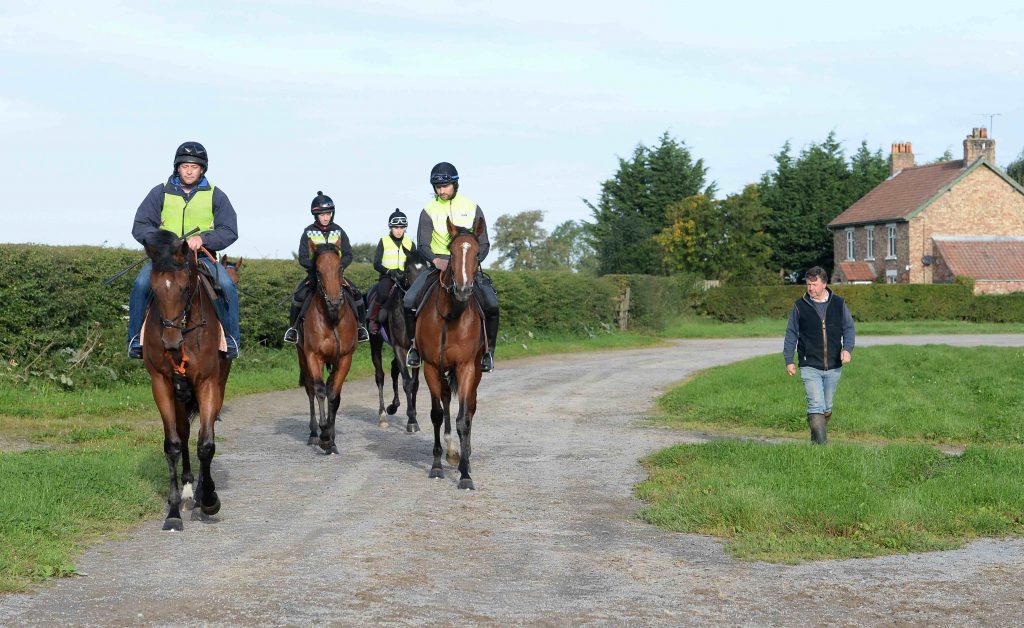Tim Easterby has been training for as long as it takes a new-born to inherit the keys to the kingdom.
After 21 years, this season has been one of his best: he has broken through the seven-figure prize-money barrier on the Flat for the fourth time, he saddled a Royal Ascot winner in June, and in Wells Farhh Go, he has what he believes is a Classic prospect.
After two successful decades, he must surely now feel that he has created his own identity. He is no longer Tim Easterby, son of Peter, but Tim Easterby, period. Put this to him and the reaction is surprising.
“I never felt any great pressure when I took over from dad,” Easterby, 56, says. “I’d worked with him for such a long time that it was second nature.
“Dad kept asking whether I wanted to take over but I wouldn’t have been ready if it had happened ten years earlier. I was when it did.”
It’s about as direct a response as you’ll get from any question levelled at any Easterby, even if it fails to address the issue of his personal identity. However, that is resolved after a lengthy pause.
Eventually, Easterby gestures at the north Yorkshire landscape around him. Everything the eye can see is owned by Peter who, like his younger brother Mick, started out with nothing.
Tim trains from three adjacent properties in Great Habton, all of them former farms bought by his father, while Mick’s empire stretches out from Sherriff Hutton, about ten miles south-west.
The brothers’ celebrated training exploits were the means to an end that now sees them unrivalled locally as land-owner farmers.
“You know, it’s amazing what dad and uncle Michael have achieved,” says Tim, who trains from the property where his grandfather raised his family in rented accommodation.
“They had 25 acres and they bought and sold horses, trained point-to-pointers and hunters. They bought the land as they went.”
Right on cue, Easterby swings his 4 x 4 up the side of the gallop to watch fourth lot and there, already in situ, is Peter.
He has already overseen an earlier lot “up on hill”, and his eyes sparkle at the prospect of watching another. To him, assessing horses at the gallop comes as naturally as inhaling the crisp September air.
Peter smiles at the memory of growing up in the house we can see across a quiet lane. “Aye,” he says. “And when I took tenancy off father in 1950, landlord tried to raise rent from £100 to £120. I took him to tribunal and got it down to £110.”
If I’m buying yearlings to sell on, the most I’d ever spend is £35,000 – £3,500 is better, mind
In the footsteps of Night Nurse and Sea Pigeon
As the horses come past, father and son exchange a flurry of half-sentences before Peter heads off to debrief the riders. The very spot we are standing on perfectly encapsulates his career. “Night Nurse and Sea Pigeon used to gallop up here,” Peter had said. “Never really went anywhere else.”
Those two horses were Turf pillars in the late 1970s. Night Nurse won two Champion Hurdles and was foiled when attempting to become the first horse to complete the Gold Cup double by his stablemate Little Owl.
Sea Pigeon also won the Champion Hurdle twice, but his popularity was rooted in the fact that he bestrode both codes. He also won two Chester Cups and the 1979 Ebor when carrying 10st.
As the morning unwinds it becomes plain that Peter never really retired. Tim is happy with that; training 120 horses is a challenge in delegation as much as anything else.
The more wise old heads around the place, the better. There are plenty of those at Habton Grange, which is a font of plain speaking.
Among them is Keith Stone, who once rode Night Nurse in a six-furlong maiden at Ripon and partnered him every day at home. Stone now helps with the entries, among other things, but can’t help casting a beady reflection back to the great horse.
“He were a right old sod,” he says. “He’d jip at everything on the gallops.”
Was he lairy, I ask?
“Noooooo,” Stone replies. “He were too thick to be lairy; were just pissing about the whole time. Never missed anything that jumped out of hedges.”
In these parts the door to the memory vault remains open even though the halcyon days now have a sepia tint. And this renders redundant the question of whether Tim Easterby craves a greater sense of his own identity.
Easterby was a wide-eyed teenager when his father carried all before him with a herd of cheaply-bought horses. In consequence, he wants to embrace the family legend rather than push it aside.
That is exactly how he has proceeded. As the years unfurl he has assumed a strong facial likeness to his father.
And there’s the same, no-nonsense approach to training horses: every one different, with different requirements. Every one bought for small money.

Tim Easterby oversees Wells Farhh Go (white blaze) and stablemates at exercise
Truth be told, Tim took over the stable when it was at a low ebb. There used to be 150 horses, an equal mix of Flat horses and jumpers, but those numbers fell away in the twilight of his father’s career. Training had become a young man’s game, but, to Tim, the ethos remains the same.
“If I’m buying yearlings to sell on, the most I’d ever spend is £35,000,” he says. “£3,500 is better, mind. Ten times better.”
Better still is to be sent horses by existing owners, which negates the need to sell them on. “They’re great for the books,” he says. “They don’t arrive with a bill.”
Easterby’s stable has also gravitated more towards Flat racing, albeit with some lament from the trainer. The Champion Hurdle is the holy grail for him but it is all down to what his clients want.
“Training jumpers is not uneconomical as long as owners want us to train them here in the north of England,” he says.
“But take a horse like My Reward. He’s a five-year-old who would make a high-class jumper but he’s running in sixty-grand races, fifty-grand races on the Flat.
“Over hurdles you have to start down below and work your way up, and there’s no point in risking him for four grand. There is so much good Flat racing around us that it makes economic sense.
“Plus, most of the jumping tracks haven’t been very adventurous with their prize-money or promoting the game. It has fallen away a lot.”
Level of consistency
The results speak for themselves. Easterby has never failed to post a half-century of winners since he first reached that landmark in the 1998 Flat season.
It’s a level of consistency that has been required to keep his operation to the fore in a part of the country populated by the winner-machines of Richard Fahey, Kevin Ryan and Mark Johnston.
Each of them has Middle Eastern patronage. It is something Easterby lacks, although he doesn’t believe it precludes him from unearthing superior horses from time to time.
It helps, no doubt about it, but Easterby, like his father, is a stockman first and foremost. Good horses come in all shapes and sizes – or in the case of Wells Farhh Go, in very large sizes indeed.
The hope is that Wells Farhh Go, who won the Group 3 Acomb Stakes at York, has what it takes to emulate Bollin Eric. He is seen as a Classic horse in the making, although ironically the dream nearly died before it was conceived.
Wells Farhh Go was that big I could easily have cut him and turned him away, like some of the others I bought. I only didn’t cut him because he is such a quiet horse
Easterby gave 16,000 guineas for the yearling son of Farhh and saw him as a long-term project. “He was a big, long horse then, but when we broke him in and cantered him he went really nicely,” he recalls.
“Then we put him upsides in the spring and he showed a bit of speed, so we left him alone. He was that big, I could easily have cut him and turned him away, like some of the others I bought. I only didn’t cut him because he is such a quiet horse.”
Wells Farhh Go is likely to round off his juvenile campaign in the Racing Post Trophy at Doncaster. By then, Easterby will have learnt whether Staxton warranted a sharp rise in the ratings for finishing fifth in the Group 2 Gimcrack Stakes, when he did not enjoy the run of the race.
There’s nothing like a batch of promising two-year-olds to raise morale in the yard. It lends a sense of purpose, although the ebb and flow of talent from one year to the next is the only difference to the ways of old.
“We still do things much the same as 20 years ago,” Easterby says. “We keep it simple. The horses have two canters on the ten-furlong all-weather gallop each morning.
“When they come by us, the key things are to look at their action and listen to their wind.”
Easterby is restrained in conversation but his short, often-unconnected observations reveal a man who keeps a very close eye on the financials. If a fool and his money are easily parted, all Easterbys must be wealthy men. It is not by accident.
Training, he says, is a profitable business so long as you make it profitable. “You have to work hard at it,” he says.
“You have to watch your figures, your feed costs, your staff costs, your incomings and outgoings. It’s a good profession to be in, even though you’ll usually be stuck with a part of most horses you buy to sell on.”
More than that, however, it is the Easterby way of life. “It is how we have done it, because that is what we wanted to do,” he says. “There is absolutely a sense of pride in where we’ve got to as a family. It’s all we know.”
Unearthing good horses on limited budgets is more difficult now than at any other time in the sport’s history. You wonder whether Peter Easterby would have been as successful had he started training today, and put that to his son.
“Oh, definitely,” Tim says, “I think there’s no doubt. Dad saw himself first and foremost as a Flat trainer, but he and uncle Michael are good businessmen. They have always been very good business people.”
The vast tract of North Yorkshire in their possession is evidence of that.
How Farhh do you go when selling?
In Tim Easterby’s case, a large part of his art is knowing when to sell. Taking a profit is akin to saddling winners when you own bits and pieces of several horses in the yard.
Easterby thus finds himself in the fortunate position of owning half of Wells Farhh Go, who won in Group 3 company at York in August. There have been offers but none has yet been sufficient for him to cash out.
“It’s hard to explain when you are in this situation,” he says. “Where do you stop; where do you even start? In the end it comes down to the size of the offer on the table, and we’ve not been tempted yet.”
Easterby’s partner in Wells Farhh Go is Alan Heley, who started off in a syndicate before graduating to ownership in his own right. The fact Heley has been a long-time supporter of the stable lends the story a pleasing symmetry.
Easterby sees much of his 2002 St Leger winner, Bollin Eric, in Wells Farhh Go. “He’s got Eric’s temperament and his attitude,” the trainer says.
“He’s got his speed, too, and he should stay. I never saw Eric as a Derby horse but it might be different with this fellow. We’ll have to see where we are with him when the Derby’s next entry stage comes along [in April].”
I want him to stay in the yard and I’d like to keep a share in him if possible. But horses are there to race, to trade
In the meantime, it’s a case of so far, so good. “I was pleased with him at York, especially as I ran him over the wrong trip,” Easterby says. “He’s not really a two-year-old and he wants at least a mile.”
Whether Easterby retains his half-share remains to be seen. “A few people asked after him when he won his maiden but we thought we had further to go with him,” he says.
“It’s a difficult decision. I want him to stay in the yard and I’d like to keep a share in him if possible. But horses are there to race, to trade.
“My partner in the horse is very happy with where we are, because we think he is going to be top-class. And when you bring them along, you don’t want to lose them.”



